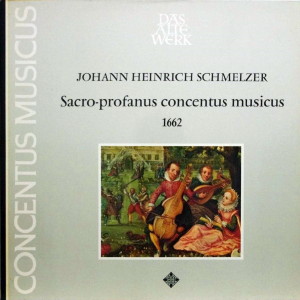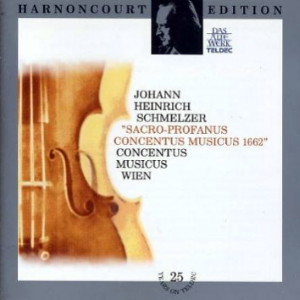 |
1 LP -
6.42100 AW - (p) 1970
|
 |
| 1 CD -
8.42100 XH - (c) 1989 |
|
| Johann Heinrich
Schmelzer (1623?-1680) |
|
|
|
|
|
|
|
| Sacro-profanus concentus
musicus... 1662 |
|
|
|
|
|
|
|
Sonata
Natalitia a 3 Chori
|
|
2' 55" |
A1
|
| für 2
Violinen, 3 Violen, 3 Piffari, Fagott, 2
Flöten, 3 Posaunen und B.c. |
|
|
|
Sonata
II a 8 duobus Choris
|
|
5' 15" |
A2 |
für
Violine, Viola, Viola da Gamba,
Violoncello, Zink, 3 Posaunen und B.c.
|
|
|
|
| Sonata a
4 "La Carolietta" |
|
6' 10" |
A3 |
für
Violine, Zink, Posaune, Dulzian und B.c.
|
|
|
|
| Sonata I
a 8 |
|
3' 52" |
A4 |
für 2
Violinen, 2 Clarinen, 3 Gamben und B.c.
(Orgel und Gambe)
|
|
|
|
Sonata a
3
|
|
4' 40" |
A5 |
für
Violine, Clarine, Posaune und B.c.
(Violone und Cembalo)
|
|
|
|
| Sonata
IV a 6 |
|
4' 20" |
B1 |
| für 2
Violinen, 3 Viola da Gamba und B.c.
(Gambe und Cembalo) |
|
|
|
| Sonata a
5 |
|
7' 10" |
B2 |
für 2
Violinen, Clarine, Fagott, Viola da
Gamba und B.c. (Cembalo)
|
|
|
|
| Sonata a
3 |
|
5' 44" |
B3 |
für
Violine, Viola, Viola da Gamba und B.c.
(Violoncello und Orgel)
|
|
|
|
Sonata a 3 Violini
|
|
5' 44" |
B4 |
| für 3
Violinen und B.c. (Violoncello und
Cembalo) |
|
|
|
|
|
|
|
Don Smithers, Zink
|
|
|
|
Concentus Musicus
Wien (mit Originalinstrumenten)
|
|
| -
Josef Spindler, Clarintrompete |
-
Alice Harnoncourt, Barockvioline |
|
| -
Richard Rudolf, Clarintrompete |
-
Walter Pfeiffer, Barockvioline |
|
| -
Hans Pöttler, Barocktrompete |
-
Peter Schoberwalter, Barockvioline |
|
| -
Ernst Hoffmann, Barocktrompete |
-
Josef de Sordi, Barockvioline |
|
| -
Andrea Wenth, Barocktrompete |
-
Stefan Plott, Barockvioline |
|
| -
Otto Fleischmann, Dulzian,
Barockfagott |
-
Kurt Theiner, Tenorbratsche |
|
| -
Jürg Schaeftlein, Barockoboe |
-
Nikolaus Harnoncourt, Tenor und
Baß Viola da Gamba |
|
| -
Karl Gruber, Barockoboe |
-
Elli Kubizek, Baß Viola da Gamba |
|
| -
Bernhard Klebel, Barockoboe |
-
Hermann Höbarth, Violoncello |
|
| -
Leopold Stastny, Renaissanceblockflöte |
-
Eduard Hruza, Violone |
|
| -
Helga Tutschek, Renaissanceblockflöte |
-
Herbert Tachezi, Orgel, Cembalo |
|
|
|
| Nikolaus
Harnoncourt, Leitung |
|
|
|
Luogo
e data di registrazione
|
| Casino Zögernitz,
Vienna (Austria) -
1969 |
|
Registrazione
live / studio
|
| studio |
Producer
/ Engineer
|
-
|
Prima Edizione CD
|
| Teldec
"Das Alte Werk" - Harnoncourt Edition 25
Jahrs on Teldec - 8.42100 XH - (1 cd) -
48' 13" - (c) 1989 - ADD |
|
Prima
Edizione LP
|
Telefunken "Das
Alte Werk" - 6.42100 AW -
(1 lp) - 48'
13"
- (p) 1970
|
|
|
Notes
|
Heinrich
Schmelzer was one of
the most interesting and
original musicians of his
day. He grew up in an army
camp because his father was
an officer. Quite probably
it was there that he
received his first
impressions of music besides
regular violin instruction.
The Polish, Hungarian,
Croatian and Bohemian
soldiers of the Austrian
army, after all, had their
musicians with them, and
some were surely excellent
and virtuoso folk musicians.
All through his life
Schmelzer was most closely
attached to folk music; most
of his works reflect his
youthful impressions while
in the army camp. Before he
was
twenty years old his violin
technique must already have
been so good that he was
engaged as violinist in the
imperial court orchestra,
His unusual talent then soon
came to the attention of the
ernperor. He had to compose
the ballet music to nearly
all of the operas. Leopold
held him in such high esteem
that in 1679, he
made him his first non-Italian
conductor at the court. -
The works on this record are
taken in part from "Sacro-profanus
concentus
musicus" (a collection of
his works that was printed
in 1662) and in part from
the Kromeřiz
archives. The latter are so
extreme in their technical
and musical demands that
surely he had written them
especially for the virtuosi
of this orchestra. -
Formally speaking, all of
these one-movement sonatas
are in the Italian style.
The various sections with
differing rhythmic
signatures are not separated
from one another by
end-of-movement pauses, but
rather are joined together
without a break. At times
the form is concluded by a
reprise.
The Christmas Sonata
"Natalitia" is, despite its
shortness, a work of
monstrous tonal richness,
with three choirs - it was
probably thought of as
pastoral music. A choir of
four piffari (oboes
with bassoon) and a choir of
two flutes and three
trombones answer the
five-part string choir that
is also supposed to be
provided in choirs.
Interestingly enough,
according to an explanatory
note in the instrument parts
the recorders may also be
replaced by soft zinks
- a further indication of
the dynamic possibilities of
the instruments of that time.
Sonata II in the "Concentus"
is written in the old
Venetian manner for two
separately placed orchestral
choirs; the instruments used
in the choirs also reflect
the old Venetian style: one
violin and three violas in
the first choir against a
zink (cornetto) and three
trombones in the second
choir, with organ and
violone (double bass)
accompaning. The violone and
zink clearly have duties to
perform as concert soloists.
Alternation between the two
choirs is less in the form
of a dialogue than of
imitation and echo.
The sonata La Carioletta is
a typical Kromeřiz
work. It was composed in
1669, and its solos for
trombone and bassoon
(actually still a late form
of the dulciana) are decades
ahead of its time. Of
especial interest is the
bassoon part, that
diminishes the bass in
obligatory paraphrases. Such
extreme scorings prove the
dynamic flexibility and
homogeneity of the old
instruments time after time.
In the eight-part Sonata I
(of the Concentus) the
thematic motifs of the
trumpet are taken over by
the violins and gambas; the
middle section (without
trumpet) offers the
opportunity to change key
and to introduce
characteristic string
figures. The dance-like
final section is again
dominated by the valveless
trumpet.
It is true that the Sonata
for Violin, Clarino and
Trombone has come down to us
in Kromeřiz
without the
composer’s name; yet
the style of writing is so
very Schmelzer-like that I
personally hold it to be one
of his works. For all
practical purposes it is a
prelude and chaconne over a
step-wise descending bass
that had been repeatedly
used since Monteverdi. Every
instrument has solo
variations with technical
demands that border on the
limits of what is humanly
possible.
In Sonata IV (of the
Concentus) it can be noticed
most clearly that
Schmelzer’s inspiration
steemed
from eastern lolk music.
This work is pure Hungarian
gypsy music in which there
are many of the special
features and rhythms that
today are still identified
with that kind of music.
Another also extremely
difficult work
is thc Sonata a 5. Once more
the bassoon part far exceeds
the normal requirenients for
the bass instrument. The
themes of this work
are determined by the
valveless trumpet. The two
violins are placed like a
choir against the two wind
instruments. In the middle
section each soloist has to
perform a "breakneck" solo -
a characteristic of nearly all Kromeřiz
Sonatas -
before they all join in to
play the dance-like closing
movement.
Although the Sonata a 3 has
come down to us without the
name of its composer, it is
still impossible for me to
imagine its composer as
having been anyone other
than Schmelzer. The
instrumentation is subtly
worked out: each of the four
different string instruments
received a task that was
typical for Schmelzer. The
violin is the dominating
solo instrument, the
violetta (a viola) and the
garnba are juxtaposed like
two choirs. There is surely
a concrete program
underlying this piece, one
that is built on the
thoroughly complicated
rhythms in the bellringing
that returns twice. The
almost romantic melancholy
of the interludes, the rich
harmony and the themes of
the Allegro parts obviously
show a strong Hungarian
influence.
Completely unlike the other
works described up to this
point is the last Sonata for
Three Violins. In this fugal
work there are no main or
secondary parts; the three
solo violins are of fully
equal rank and constantly
pass the lead from one to
another. The middle section
is a harmonically
bold Adagio that, after a
short interlude, runs into
the final dance that is
written over a basso
ostinato.
Nikolaus
Harnoncourt
|
|
Nikolaus
Harnoncourt (1929-2016)
|

|

|
|